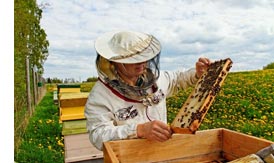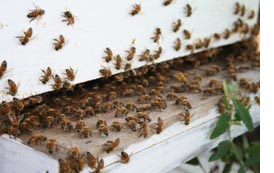The Bee Beat
- By Heidi Lewis
- Reading Time: 4 mins.

Notes From a Freshman Beekeeper
Who is a bee’s favorite singer? Sting. Favorite band? The Bee Gees. Why do bees hum? Because they don’t know the words—OK, OK, enough of the second-grade jokes. It’s just that the bee situation could use a little levity: It appears that this winter may have been the hardest yet for honeybees, which have been suffering massive die-offs since 2006 due to a mysterious disease known as colony collapse disorder (CCD). (See What’s Killing the Bees.)
The Bee Informed Partnership won’t have its official numbers on this past winter’s losses until early May, but Eric Mussen, an apiculturalist at the University of California, Davis, ventured a guess on the NPR radio program Science Friday that the average loss to beekeepers nationwide will be greater than 35 percent.
There are some 150,000 non-commercial backyard beekeepers across the country, of which I am one. And I experienced a 100 percent loss this winter—though I believe that it wasn’t due to CCD but my rotten luck. Last spring I purchased a nuc—a mini hive with five frames of brood and a queen. From the onset I was unable to locate the queen, and the hive did not thrive in its first two months. Bee expert Doug Vincent’s diagnosis was that I had “lost” the queen, and the hive didn’t grow because the worker bees needed time and energy to make a new one.
The Queen Is Dead, Long Live the Queen
How I lost the queen we will never know. She may have been locked out when I moved the hive, or I may have accidentally crushed her. Thinking back on it now, when I raised the roof on the hive, the bees made a high-pitched whine like a Kawasaki motorcycle, as opposed to their usual low hum. An old-timer told me later that that is the sound of a queen-less hive.

A hive “knows” within hours when it has lost its queen and goes into emergency mode to make a new one. They do this by feeding royal jelly to a worker bee larva; the queen develops from this larva and in about 24 days emerges for her nuptial flight. She can then start laying eggs. Those were crucial days that my hive lost during the summer nectar flow, so it went into the winter months a bit behind. By midwinter I could tell they were gone. I held my ear against the box and it was silent.
Early this spring I opened the hive to try to see what got ’em. I had seen some yellow jackets nosing around and immediately wanted to peg them as the culprits because of my prejudices against wasps. The upshot is, though, that I just don’t know. It probably was not CCD, because in that case all the worker bees depart, leaving the queen to starve, while in mine the queen was gone as well. I saw wax capping at the bottom of the hive, indicating that they raided the pantry, loaded up on honey, and split in a hurry. It’s likely they succumbed to some environmental stressor, of which there are so many these days.
Bee Positive
I hesitate to admit how emotionally invested I was in a bunch of insects—it’s not like they were pets—but losing the hive was devastating. Still, I will try again. I’m learning more each year as I swim with the rising tide of novice beekeepers. We are a hopeful and optimistic bunch. This year I’m getting two packages of bees, a slightly different way to get started. Basically, you receive a box of bees and a queen in a small test tube. They will have to build their hive from the ground up, but this way I can see the queen from the get-go.
Since 2009, urban beekeeping has risen 220 percent in cities like New York and London. People are getting involved in beekeeping for all kinds of reasons—as a hobby, because of environmental concerns, or just as naturalists and citizen scientists. Beginner classes throughout the country are full. But it’s not too late if you want to get involved—find a bee supply store or contact your local beekeepers association (the magazine Bee Culture has a list of associations by state); they usually have classes, a library, and a list of mentors. Or contact your local community college, sustainable farming and garden groups, or farm bureau.
Here are some resources to help you get started:
- Bee Culture: The Magazine of American Beekeeping
- The Pollinator Partnership’s resources page
- TheDailyGreen’s guide for beginning beekeepers
- Beekind’s video on the best way to set up a beehive
Bees will need a lot of love and serious policy action if there’s to be any change in their situation. Here are some things you can do to support bees and beekeepers:
- Buy local honey, beeswax candles, and bee products.
- Plant bee-friendly plants that provide pollen at different times of the year. The Pollinator Partnership has a series of free pollinator-friendly planting guides by eco-region.
- Provide variety. Bees prefer gardens that have 10 or more species of plants that are attractive to them. They also like a variety of colors, and are particularly attracted to blue, purple, violet, white, and yellow.
- Don’t use pesticides. If you must, use fast-acting ones and apply them in the evening or at night, when pollinators are least active.
- If you spot a swarm, call a responsible beekeeper—not pest control.
- Be calm and observe the bees in their work. They are fascinating creatures.
For more ways to help bees, see What’s Killing the Bees.
For so work the honeybees, creatures that by a rule in nature teach the act of order to a peopled kingdom. –William Shakespeare


